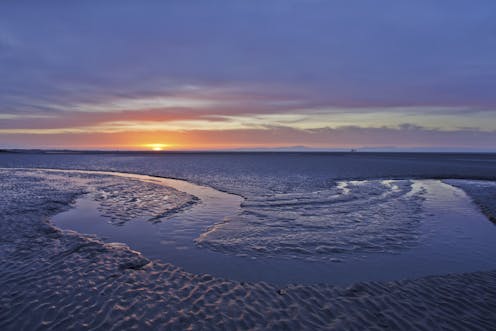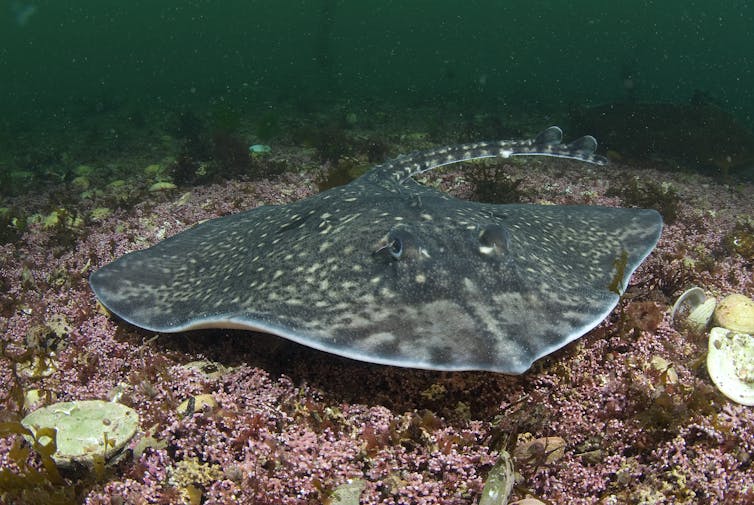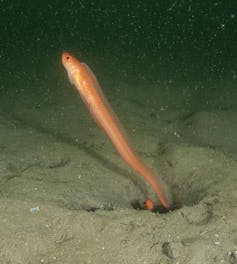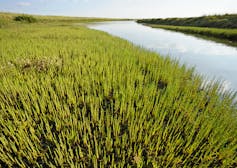The world’s oceans are home to different habitats that capture and store carbon – known as “blue carbon”. These include habitats that are typically found along coastlines, such as salt marshes and seagrasses, as well as vast seabed sediments further offshore made of mud, silt and sand. The extent to which these habitats are protected and, where possible, restored, could have huge implications for the world’s future climate.
Until now, there was limited coordination of information about how much carbon is stored in UK marine habitats, especially in seabed sediments. But a new report from the Blue Carbon Mapping Project, published today, provides a new baseline for the UK’s blue carbon. In fact, the UK is the first nation to map and estimate the amount of carbon stored in all of its seabed habitats and this milestone could influence marine policy both here and around the world.
The Blue Carbon Mapping Project, completed by the Scottish Association for Marine Science on behalf of World Wildlife Fund, The Wildlife Trusts and the RSPB, gives the UK an opportunity to show the rest of the world just how important blue carbon is and why we need to protect it. Helping nature to recover on land and at sea is fundamental for tackling climate change, alongside reductions in emissions.
A thornback ray swims over a coral-like maerl bed in the Fal, Cornwall – just one of the many blue carbon-rich ecosystems around UK coasts. Paul Naylor, CC BY-NC-ND
My colleagues and I reviewed and collated existing data about blue carbon habitats and carbon in seabed sediment to create new estimates of the size of and rates of accumulation in the carbon stores in UK seas. We found that seabed sediments are the largest blue carbon store, holding an estimated 244 million tonnes of organic carbon. Most (98.3%) of this carbon is stored within the top 10cm of these sediments.
Coastal vegetated habitats, although covering only 1% of the UK’s marine area, contribute significantly to carbon storage, accounting for 1.7% of the UK seas’ total organic carbon stores. Salt marshes are the largest of these, containing 60% of the organic carbon in coastal vegetated habitats. Mostly found in England and Wales, salt marshes are powerful carbon sinks due to the rich, organic soils they contain. Seagrass beds, though less extensive, also play a critical role, but our report calls for improved mapping to better understand their distribution and capacity.
When unharmed, marine habitats naturally absorb carbon and prevent it being released into the atmosphere. The carbon is primarily absorbed by phytoplankton that drift to the bottom of the sea when they die and are added to seabed sediments. Providing they are left undisturbed, these sediments can continue to absorb carbon for hundreds, if not thousands of years.
Improving protection
In today’s busy seas, blue carbon stores are vulnerable to human pressures that can cause them to be disturbed, damaged or removed entirely – for example, some commercial fishing practices or industrial developments . Ultimately, this can hinder or eliminate the ability of a habitat to store and capture carbon.
Red bandfish, a species that burrows in the sediment. Paul Naylor, CC BY-NC-ND
Long-term carbon storage in the sea relies on protecting blue carbon habitats from damage. That means strategically planning different activities that rely on healthy seas and avoiding disturbances to the seabed. In the UK, there is a network of marine protected areas that help to protect key habitats and species from harm, but these areas were not designated based on their value for capturing or storing carbon.
Now, policymakers have at their disposal new and important data that could be used to introduce more robust protections for blue carbon in UK waters. This could help to achieve both climate and biodiversity goals, including net zero and the international agreement to protect 30% of seas by 2030.
Salt marsh like this can be regenerated to help coastal habitats store more carbon. Terry Whittaker, CC BY-NC-ND
Protecting coastal habitats and seabed sediments from damage is a nature-based solution for keeping carbon in the ground. These measures can also provide other social and economic benefits, such as nursery grounds for fish, and better protections from storms.
By consolidating a wealth of information sources, we have gained valuable insights into the carbon storage of seabed habitats around our shores. What we do with that data could have implications for generations to come.



 Parasites are ecological dark matter – and they need protecting
Parasites are ecological dark matter – and they need protecting  GesiaPlatform Launches Carbon-Neutral Lifestyle App ‘Net Zero Heroes’
GesiaPlatform Launches Carbon-Neutral Lifestyle App ‘Net Zero Heroes’  We combed through old botanical surveys to track how plants on Australia’s islands are changing
We combed through old botanical surveys to track how plants on Australia’s islands are changing  LA fires: Fast wildfires are more destructive and harder to contain
LA fires: Fast wildfires are more destructive and harder to contain  How to create a thriving forest, not box-checking ‘tree cover’
How to create a thriving forest, not box-checking ‘tree cover’  Lake beds are rich environmental records — studying them reveals much about a place’s history
Lake beds are rich environmental records — studying them reveals much about a place’s history  Fungi are among the planet’s most important organisms — yet they continue to be overlooked in conservation strategies
Fungi are among the planet’s most important organisms — yet they continue to be overlooked in conservation strategies  What’s so special about Ukraine’s minerals? A geologist explains
What’s so special about Ukraine’s minerals? A geologist explains  Rise of the Zombie Bugs takes readers on a jaw-dropping tour of the parasite world
Rise of the Zombie Bugs takes readers on a jaw-dropping tour of the parasite world  Extreme heat, flooding, wildfires – Colorado’s formerly incarcerated people on the hazards they faced behind bars
Extreme heat, flooding, wildfires – Colorado’s formerly incarcerated people on the hazards they faced behind bars  As the Black Summer megafires neared, people rallied to save wildlife and domestic animals. But it came at a real cost
As the Black Summer megafires neared, people rallied to save wildlife and domestic animals. But it came at a real cost  How ongoing deforestation is rooted in colonialism and its management practices
How ongoing deforestation is rooted in colonialism and its management practices 

































